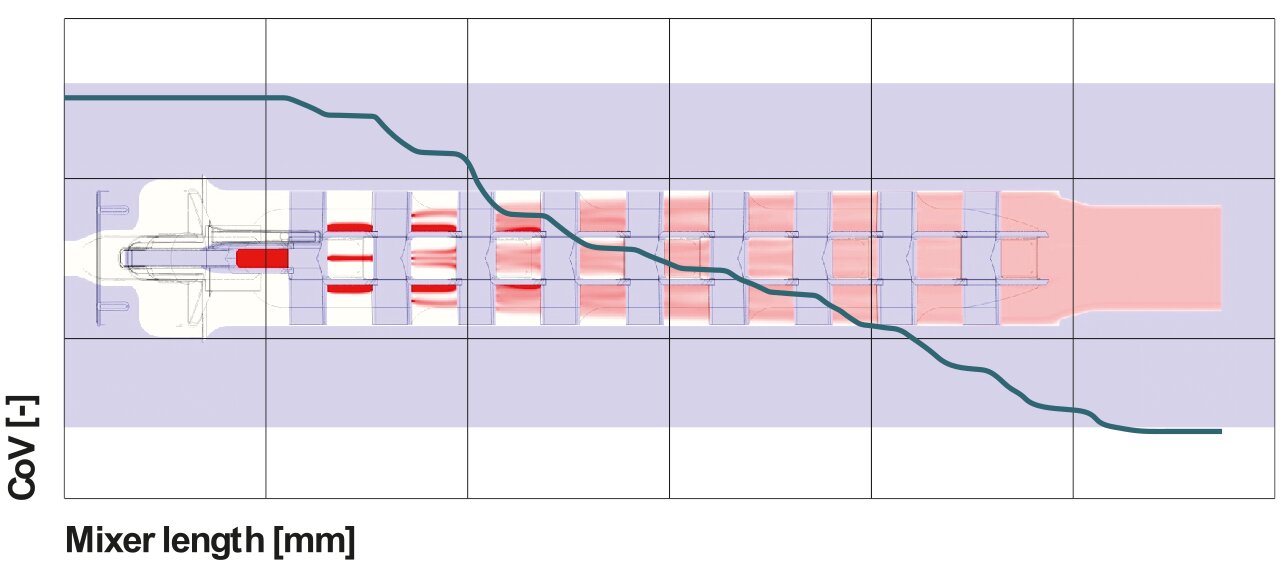Numerical Flow Simulation of mixers
MIXING TECHNOLOGY AT MEDMIX AG – Flow simulations or CFD (Computational fluid dynamics) is an established procedure to analyze and solve problems that involve fluid flows with the help of computers. With this method it is possible to examine the internal or external flow field of a product virtually before a first prototype has been produced. In this way, a design version can be analyzed realistically and, if necessary, optimized by constructive adjustments. In the best case, only a few necessary tests are carried out later. Thus, CFD simulations can accelerate development cycles and lead to a reduction in development costs.
1.1.Introduction to CFD
CFD involves the solution of the governing laws of fluid dynamics numerically. The complex set of partial differential equations are solved on in geometrical domain divided into small volumes, commonly known as computational mesh The aim of this article is to give an overview of how a typical CFD simulation is set up and how it can be used during the product development process of mixing and applicator systems. In general, a typical CFD analysis consists of three steps:
- Pre-processing phase
- Execution of the simulation
- Post-processing of the results for visualization, parameter extraction and optimization
1.2.Pre-processing
The keyword pre-processing includes all activities that are carried out before the actual simulation is executed. This starts with the use of computer aided design (CAD) to build up the geometry and suitable physical boundaries of the problem. Geometry preparation and simplification: From there, the fluid volume to simulate has to be extracted. During this step it is often useful to remove geometrical details that are not important for the intended analysis. For example, this can be small holes, radii or gaps without flow. The aim of this work is to reduce the complexity of the model and to focus on the essential details in order to ultimately reduce analysis time and costs without losing accuracy.
 Figure 1 - Process of geometry preparation and discretization
Figure 1 - Process of geometry preparation and discretization
Discretization: In the second step the volume occupied by the fluid is divided into discrete cells (the mesh). The mesh generated should be fine enough to cover the major physical effects. The type of mesh should be advantageously hexahedral-dominant or at least of polyhedral type. Simple tetrahedral meshes are not adequate to obtain appropriate results.
Physical models: Depending on the type of problem to be solved during an investigation, simulations with different complexity in terms of physical models and numerical effort can be carried out. In the easiest case a steady state solver is used to simulate the flow of an incompressible and isothermal fluid in laminar flow. Multi-component or multi-phase models can be added to cover the flow of several components in one fluid domain. In the case of low viscous materials, a turbulence model has to be switched on. To solve time-dependent effects or flow fluctuations a transient solver has to be taken.
Boundary condition and fluid properties: The last step includes the definition of the fluid properties of all fluid involved. In simple cases this is the fluid density and the fluid viscosity. In more sophisticated cases with heat transfer and multiple materials this can also be thermal expansion, heat capacity, surface tension and contact angle. Operating and initial conditions are defined at the boundaries of the simulation domain.
1.3.Execution of the simulation
To run the CFD simulation the so-called Navier-Stokes equations have to be solved. In physics, the Navier–Stokes equations are partial differential equations which expresses the conservation of mass, momentum, energy and additional scalar fields.
 Figure 2 - Convective form of Navier-Stokes momentum equation
Figure 2 - Convective form of Navier-Stokes momentum equation
1.4. - Postprocessing
Postprocessing refers to the evaluation of the CFD simulation results. This can be done graphically in terms of contour, vector or streamlines plots, videos or quantitatively by tables of values. Like for all numerical simulation it is suggested to prove the plausibility of the numerical results. This can be done by comparing them with rough hand calculations or measurement data of similar designs.
Qualitative flow analysis is often done graphically by means of contour or vector plots. Generally, the pressure and velocity field are of main interest. In the case of mixer simulations, the concentration field of the components to mix is relevant. These plots can be analyzed to find critical areas, for example with high pressure losses or unwanted death zones with almost no flow. Quantitative flow analysis of variables or flow parameters (for example: mixing quality or pressure loss) are generally determined at pre-defined locations within the simulation domain. For example, in simulations of static mixers the evaluation of mixing quality over the mixer length is of interest. In the case of transient simulations, these values can also be evaluated over time.
 Figure 3 - Mixing quality in a static mixer
Figure 3 - Mixing quality in a static mixer
A combination of both quantitative and qualitative evaluation is shown in Figure 13. Here, the underlying picture is a contour plot of the mass fraction of component B in a static mixer. The overlaid blue curve shows the progress of CoV (Coefficient of Variation) which is a measure for mixing quality over the mixer length. While the CoV remains unchanged (no mixing) in the mixer head and mixer outlet, it decreases nearly linearly in the mixing elements if the CoV is plotted logarithmically.
1.5.Advantages of CFD in comparison with measurements and its limitations
Nowadays CFD is found in almost all fields ranging from medical research to engineering. And there are important advantages because CFD is used:
- CFD can be used as a qualitative tool for pre-evaluation of various designs. Designers and analysts can study prototypes numerically, and then test by experimentation only those which show promise. This leads to a great time and cost reduction in the development process.
- CFD can provide results for flow problems which can hardly be analyzed by means of measurements or which are even dangerous, for example if hazardous substances had to be tested.
- CFD offers the capacity to study products or systems under conditions beyond their limits. This can be interesting to understand how a system reacts when used incorrectly.
- CFD allows observation of flow properties without disturbing the flow itself, which is not always possible with conventional measuring instruments.
- CFD generates colorful pictures and graphs which helps to understand the system. And finally, it can be used for marketing reasons to convince development partners of the functionality of a product.
State of the art CFD solvers can handle a wide range of different physical models. But with increasing complexity (multi-phase, multi-components, chemical reactions, ….) and highly transient behavior with phenomena which often appears at different time scales the numerical effort to obtain a meaningful result increase dramatically. In addition, often the exact fluid properties of the fluids of interest are not known in detail or are confidential for different reasons. And even the most sophisticated CFD model is still a particularly good simplification of the reality, only. Thus, in many cases measurements are still the means of choice and a particularly crucial resource to validate the simulation models. It has often been shown that the best development results were achieved with a well-considered combination of simulations and measurements.
About the author:
"Joachim Schöck has been working as a senior technology expert at Sulzer Mixpac and medmix Switzerland AG for 12 years. His main activity is the optimization and further development of high-precision application and mixing systems. This is done to a large extent using modern simulation tools such as CFD and FEM. Another focus is on the further development of test methods for predicting the mixing quality of 2K adhesives and sealants."
